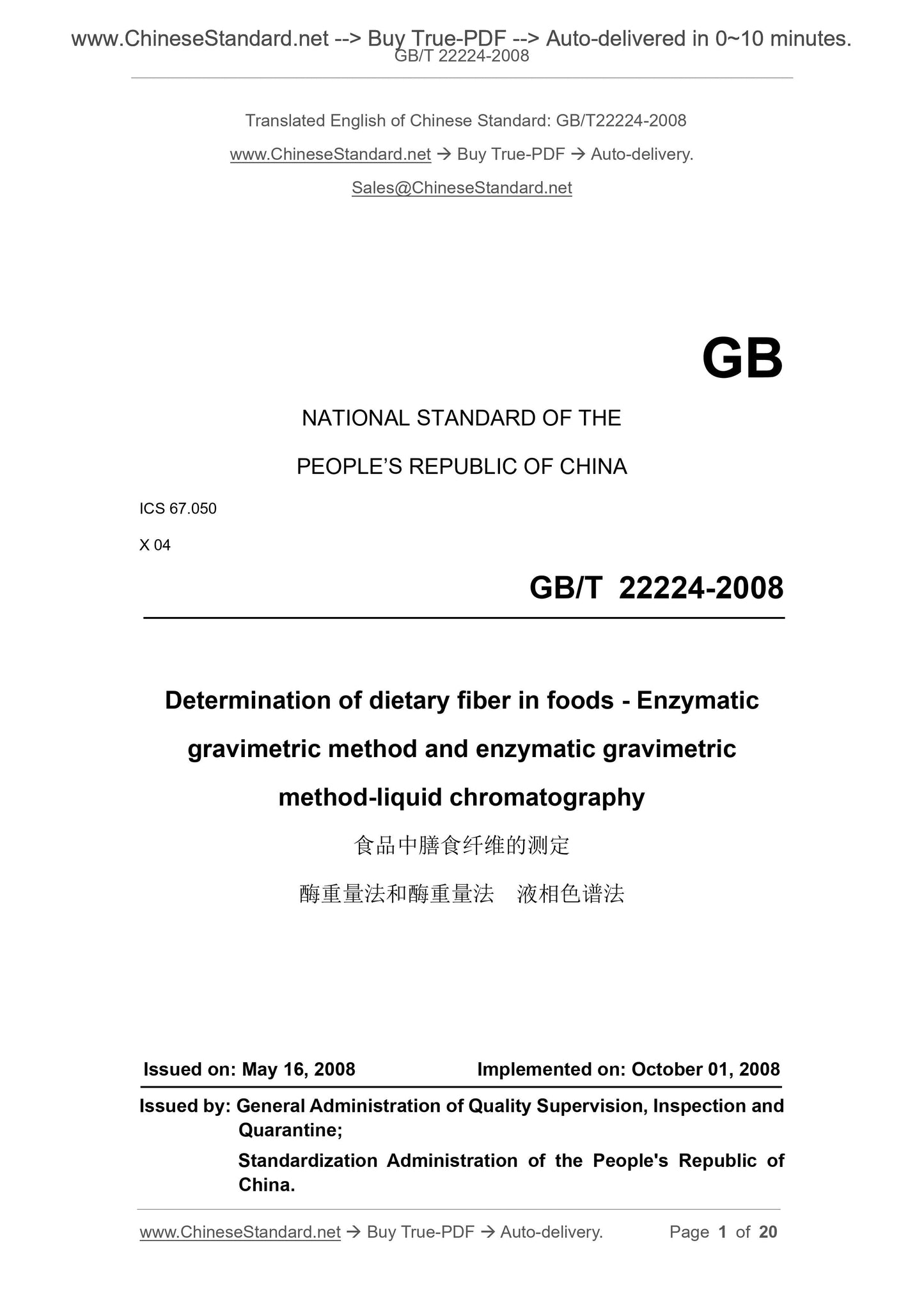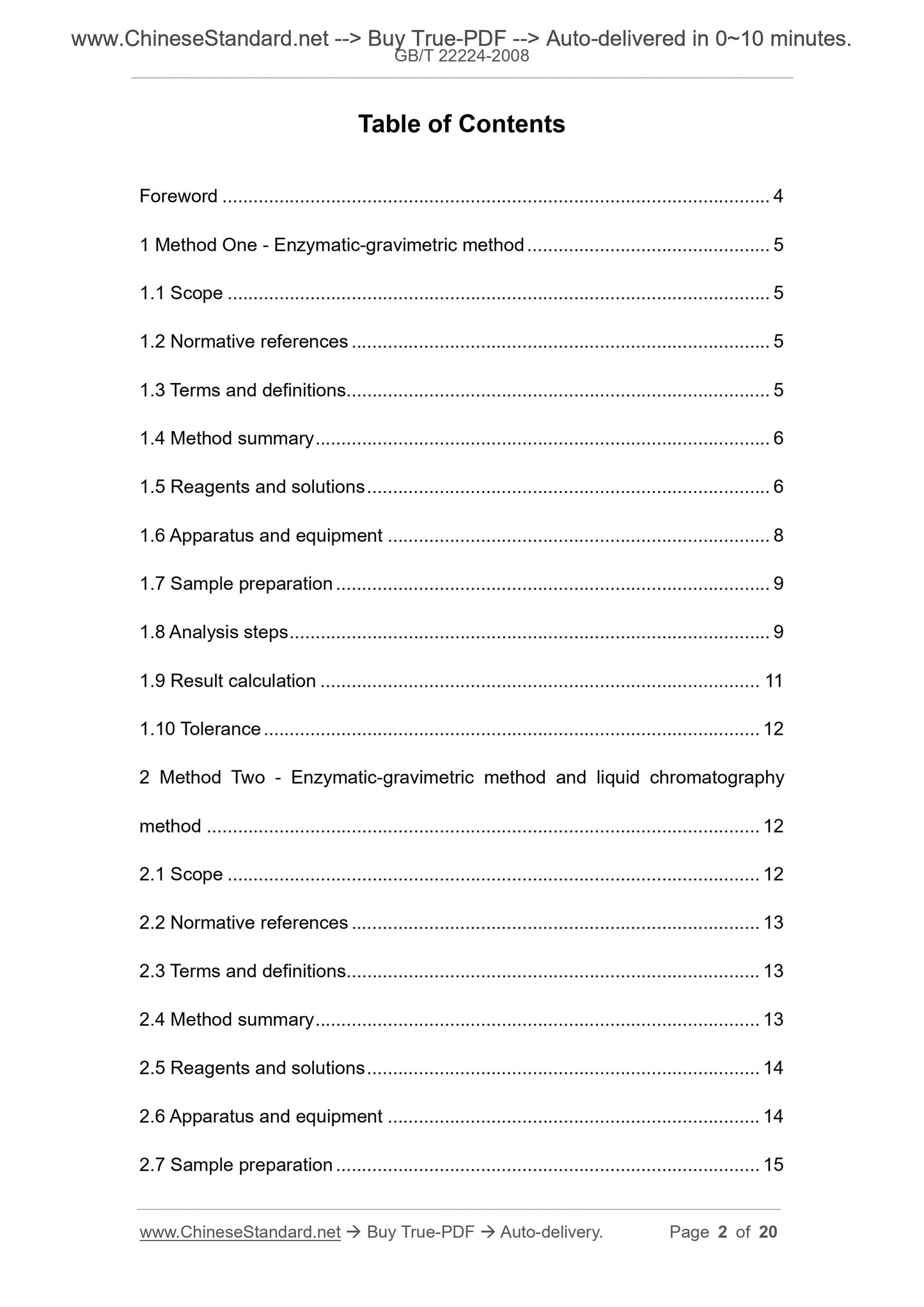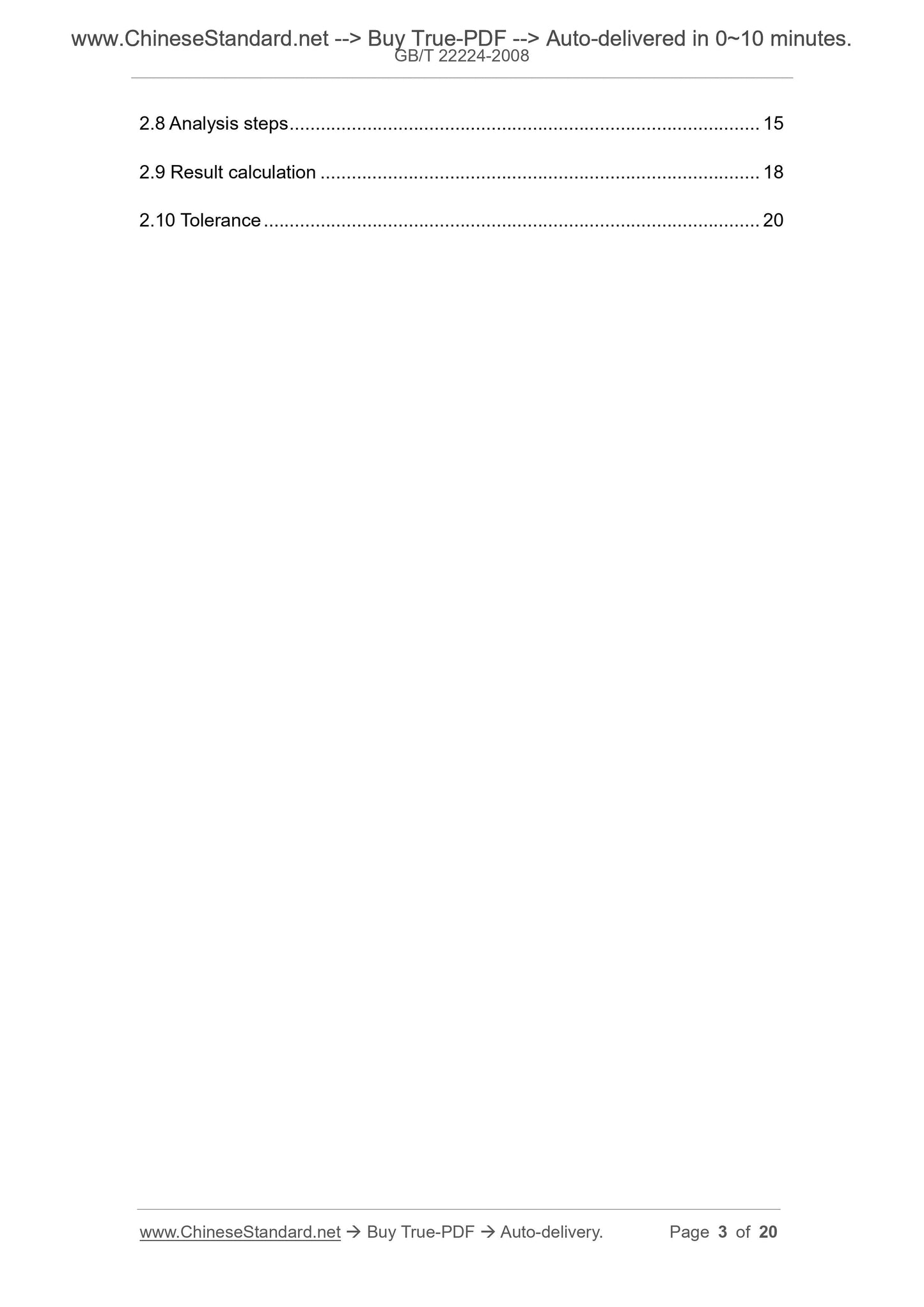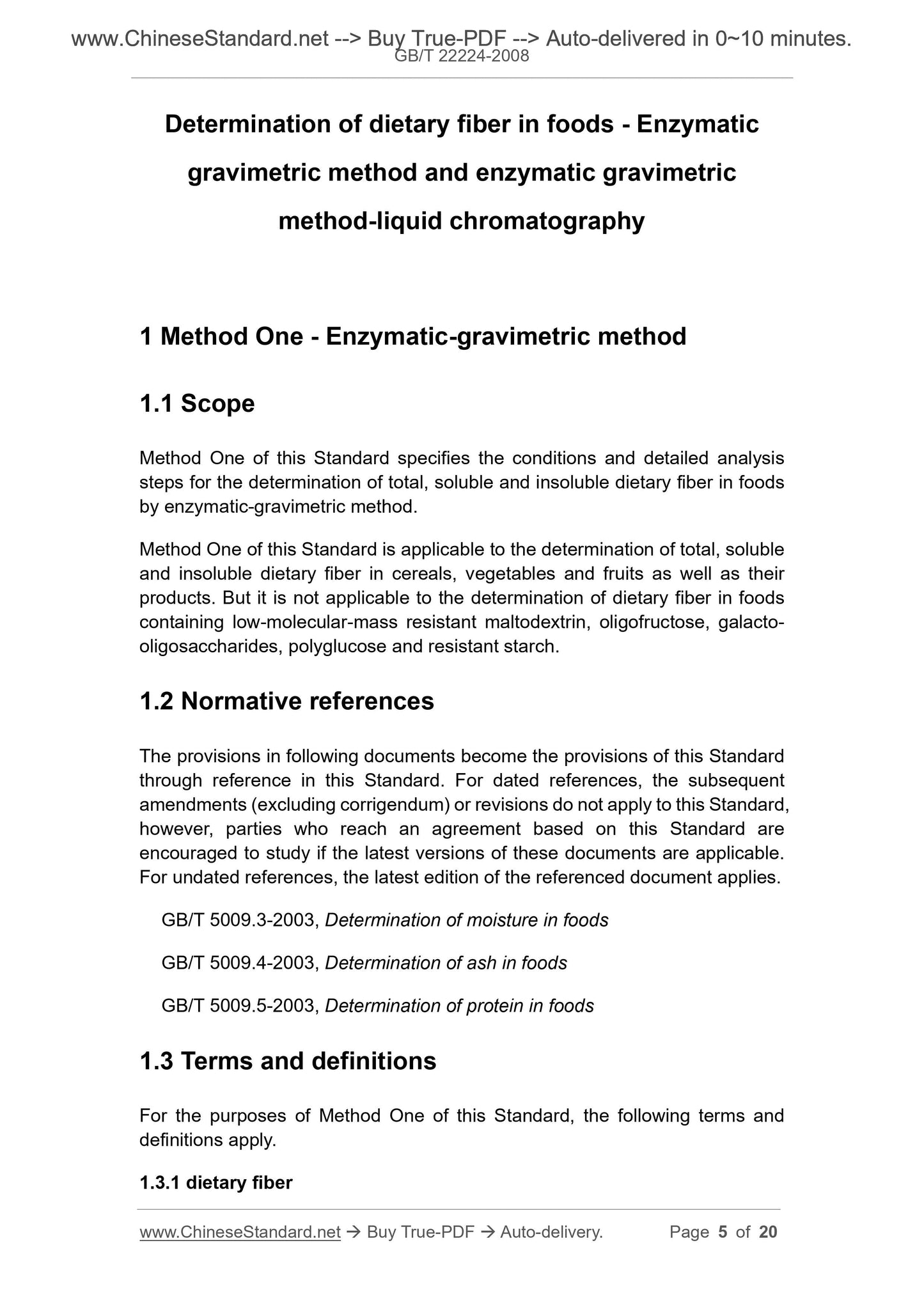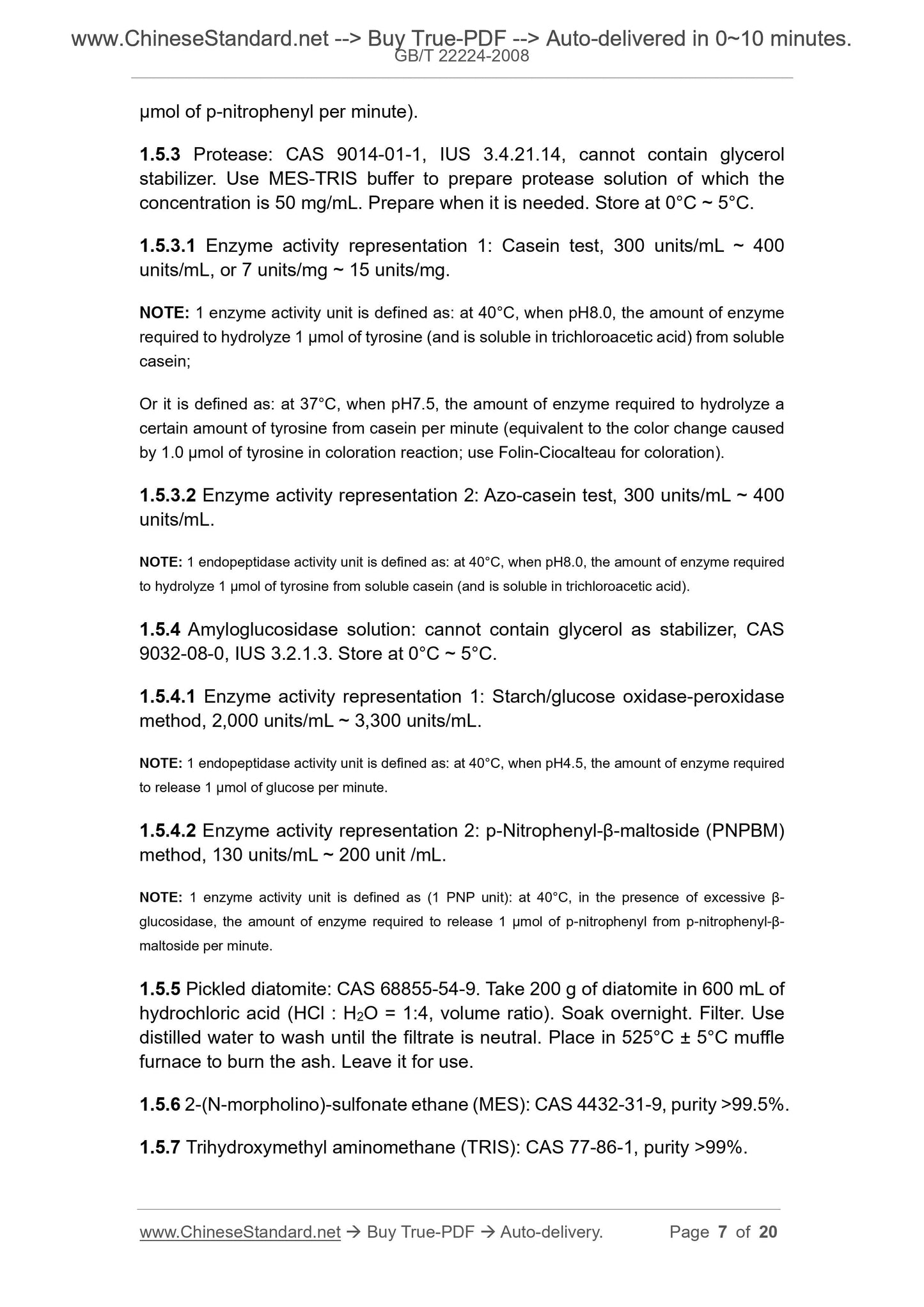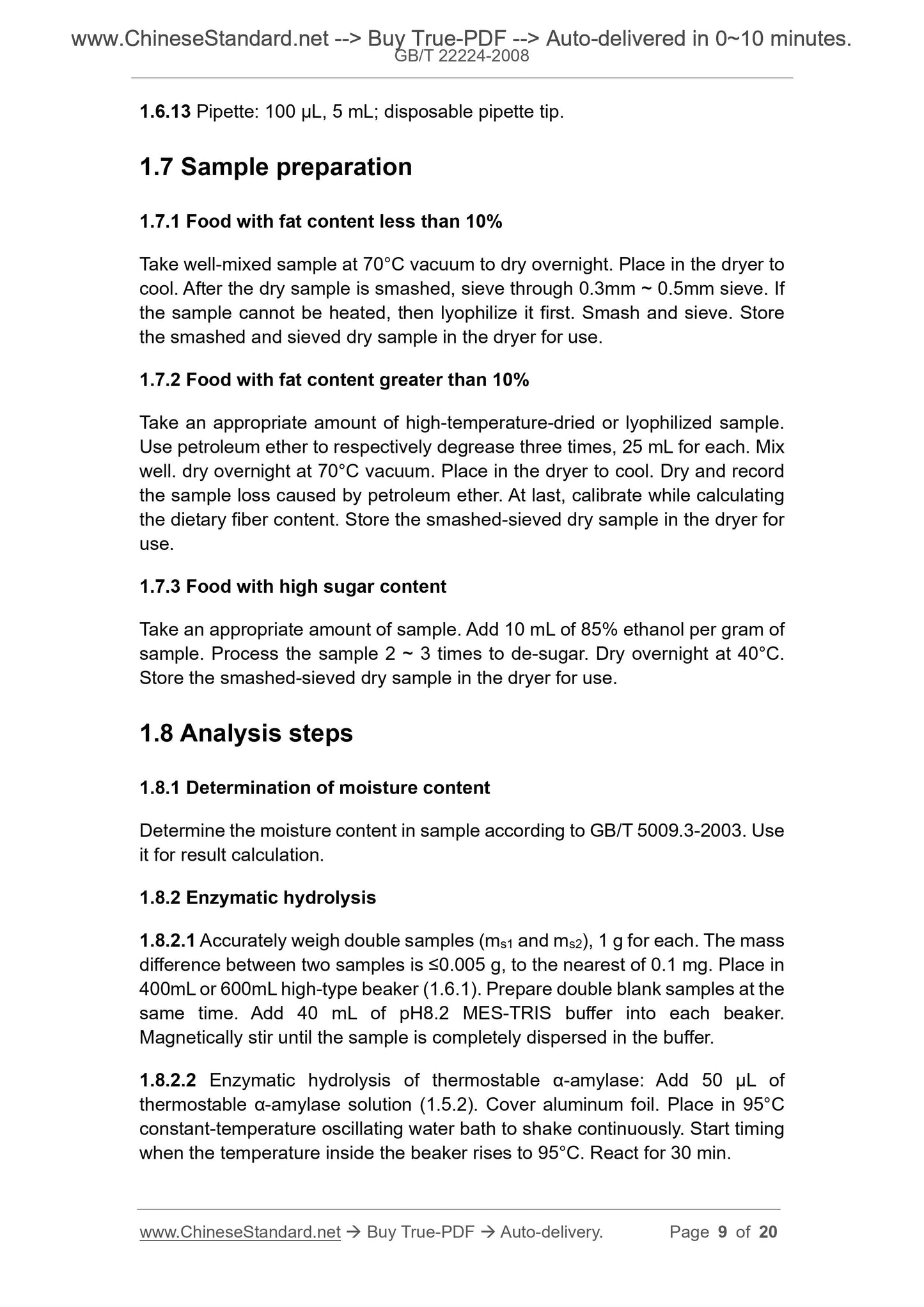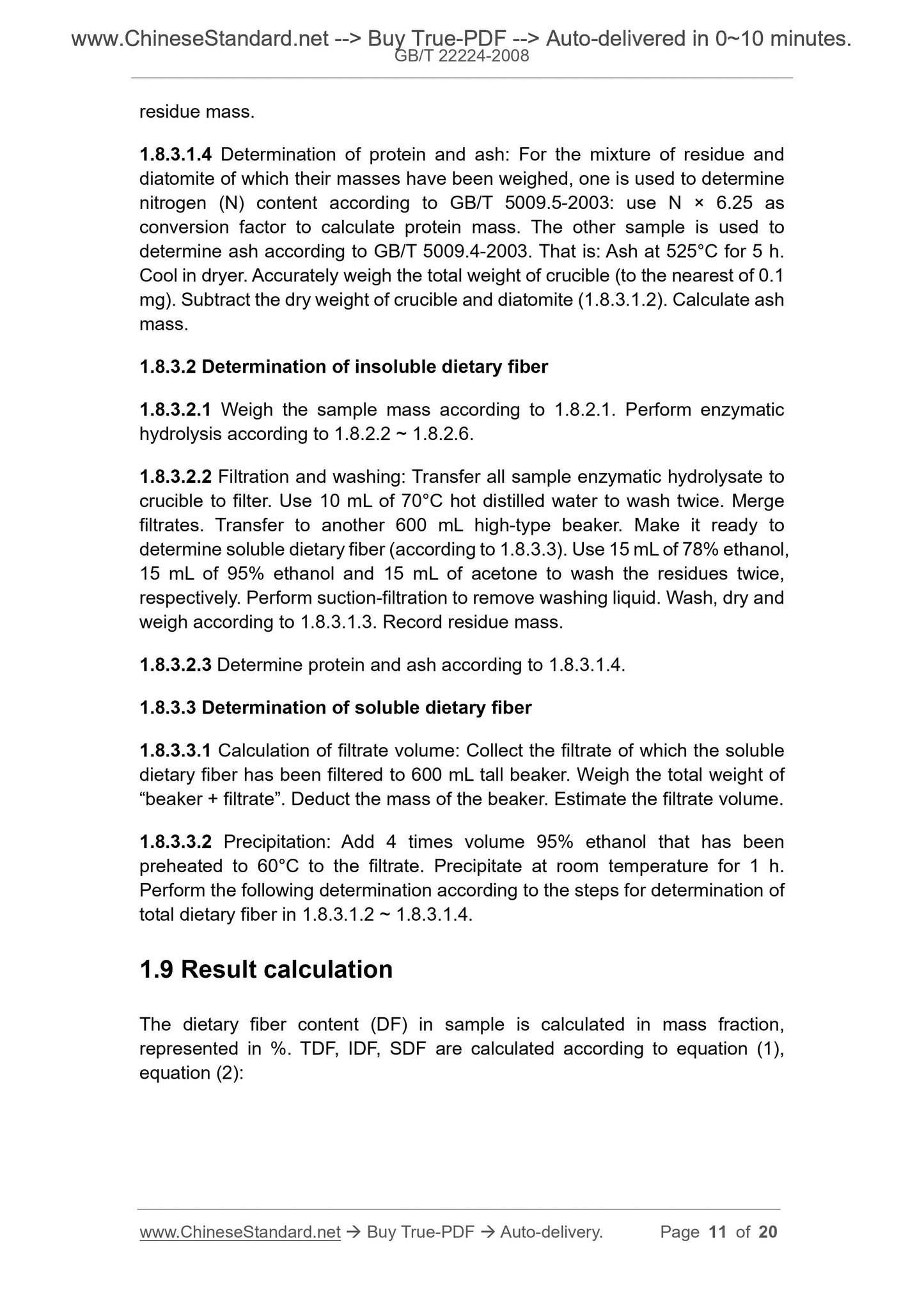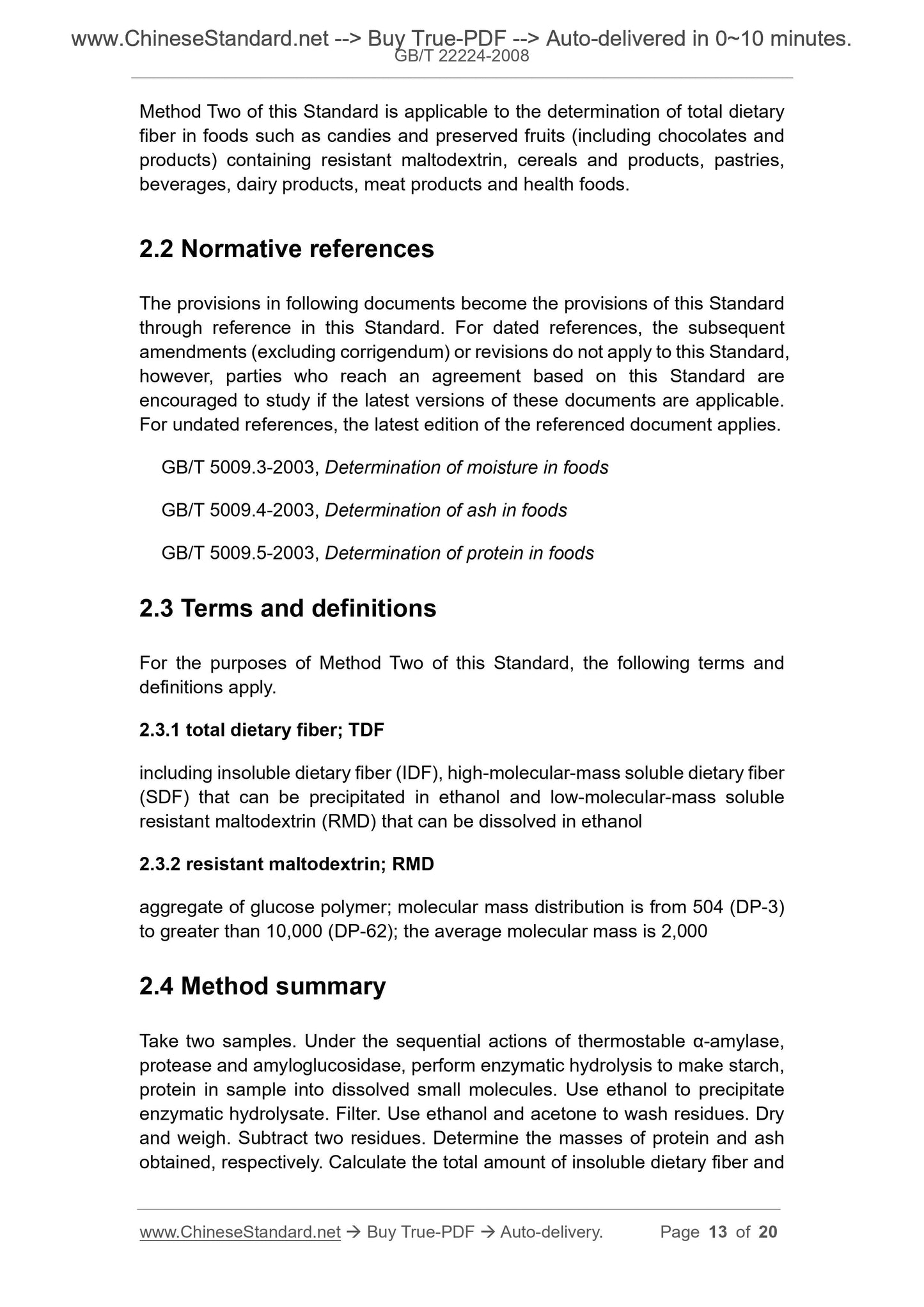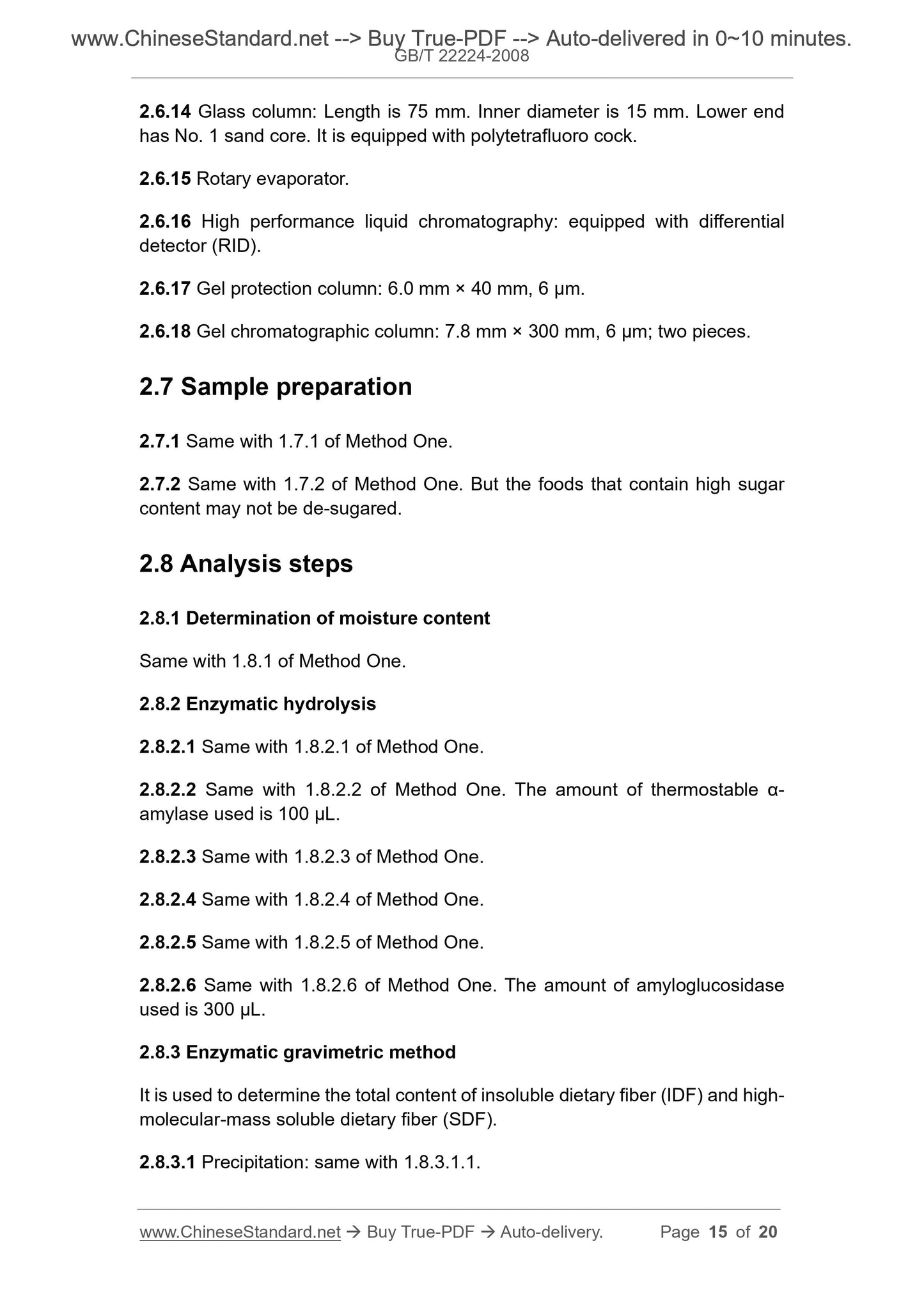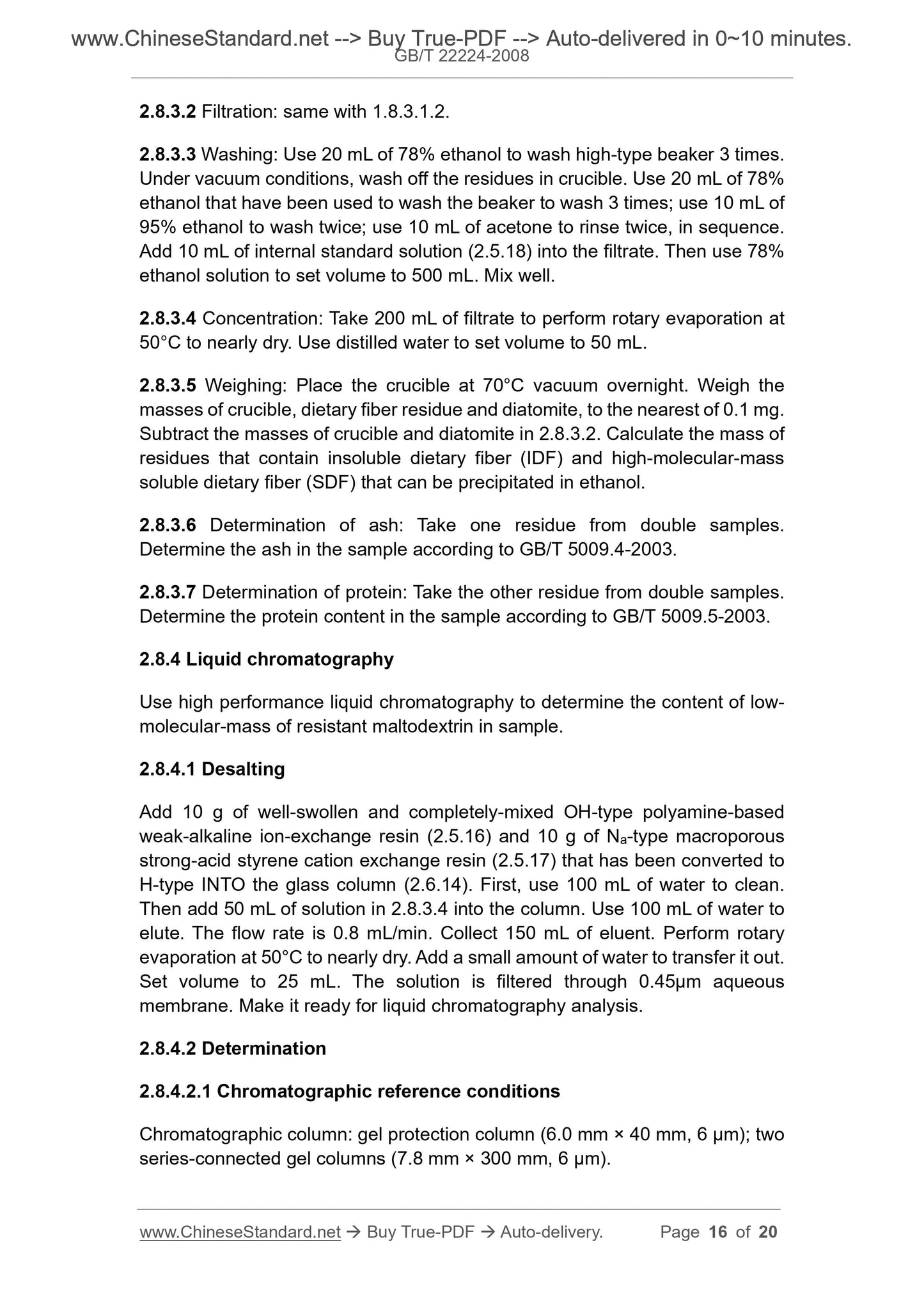1
/
of
10
www.ChineseStandard.us -- Field Test Asia Pte. Ltd.
GB/T 22224-2008 English PDF (GB/T22224-2008)
GB/T 22224-2008 English PDF (GB/T22224-2008)
Regular price
$160.00
Regular price
Sale price
$160.00
Unit price
/
per
Shipping calculated at checkout.
Couldn't load pickup availability
GB/T 22224-2008: Determination of dietary fiber in foods -- Enzymatic gravimetric method and enzymatic gravimetric method -- Liquid chromatography
Delivery: 9 seconds. Download (and Email) true-PDF + Invoice.Get Quotation: Click GB/T 22224-2008 (Self-service in 1-minute)
Newer / historical versions: GB/T 22224-2008
Preview True-PDF
Scope
1.1 ScopeMethod One of this Standard specifies the conditions and detailed analysis
steps for the determination of total, soluble and insoluble dietary fiber in foods
by enzymatic-gravimetric method.
Method One of this Standard is applicable to the determination of total, soluble
and insoluble dietary fiber in cereals, vegetables and fruits as well as their
products. But it is not applicable to the determination of dietary fiber in foods
containing low-molecular-mass resistant maltodextrin, oligofructose, galacto-
oligosaccharides, polyglucose and resistant starch.
1.2 Normative references
The provisions in following documents become the provisions of this Standard
through reference in this Standard. For dated references, the subsequent
amendments (excluding corrigendum) or revisions do not apply to this Standard,
however, parties who reach an agreement based on this Standard are
encouraged to study if the latest versions of these documents are applicable.
For undated references, the latest edition of the referenced document applies.
GB/T 5009.3-2003, Determination of moisture in foods
GB/T 5009.4-2003, Determination of ash in foods
GB/T 5009.5-2003, Determination of protein in foods
1.3 Terms and definitions
For the purposes of Method One of this Standard, the following terms and
definitions apply.
1.3.1 dietary fiber
μmol of p-nitrophenyl per minute).
1.5.3 Protease: CAS 9014-01-1, IUS 3.4.21.14, cannot contain glycerol
stabilizer. Use MES-TRIS buffer to prepare protease solution of which the
concentration is 50 mg/mL. Prepare when it is needed. Store at 0°C ~ 5°C.
1.5.3.1 Enzyme activity representation 1: Casein test, 300 units/mL ~ 400
units/mL, or 7 units/mg ~ 15 units/mg.
NOTE: 1 enzyme activity unit is defined as: at 40°C, when pH8.0, the amount of enzyme
required to hydrolyze 1 μmol of tyrosine (and is soluble in trichloroacetic acid) from soluble
casein;
Or it is defined as: at 37°C, when pH7.5, the amount of enzyme required to hydrolyze a
certain amount of tyrosine from casein per minute (equivalent to the color change caused
by 1.0 μmol of tyrosine in coloration reaction; use Folin-Ciocalteau for coloration).
1.5.3.2 Enzyme activity representation 2: Azo-casein test, 300 units/mL ~ 400
units/mL.
NOTE: 1 endopeptidase activity unit is defined as: at 40°C, when pH8.0, the amount of enzyme required
to hydrolyze 1 μmol of tyrosine from soluble casein (and is soluble in trichloroacetic acid).
1.5.4 Amyloglucosidase solution: cannot contain glycerol as stabilizer, CAS
9032-08-0, IUS 3.2.1.3. Store at 0°C ~ 5°C.
1.5.4.1 Enzyme activity representation 1: Starch/glucose oxidase-peroxidase
method, 2,000 units/mL ~ 3,300 units/mL.
NOTE: 1 endopeptidase activity unit is defined as: at 40°C, when pH4.5, the amount of enzyme required
to release 1 μmol of glucose per minute.
1.5.4.2 Enzyme activity representation 2: p-Nitrophenyl-β-maltoside (PNPBM)
method, 130 units/mL ~ 200 unit /mL.
NOTE: 1 enzyme activity unit is defined as (1 PNP unit): at 40°C, in the presence of excessive β-
glucosidase, the amount of enzyme required to release 1 μmol of p-nitrophenyl from p-nitrophenyl-β-
maltoside per minute.
1.5.5 Pickled diatomite: CAS 68855-54-9. Take 200 g of diatomite in 600 mL of
hydrochloric acid (HCl : H2O = 1:4, volume ratio). Soak overnight. Filter. Use
distilled water to wash until the filtrate is neutral. Place in 525°C ± 5°C muffle
furnace to burn the ash. Leave it for use.
1.5.6 2-(N-morpholino)-sulfonate ethane (MES): CAS 4432-31-9, purity >99.5%.
1.5.7 Trihydroxymethyl aminomethane (TRIS): CAS 77-86-1, purity >99%.
1.6.13 Pipette: 100 µL, 5 mL; disposable pipette tip.
1.7 Sample preparation
1.7.1 Food with fat content less than 10%
Take well-mixed sample at 70°C vacuum to dry overnight. Place in the dryer to
cool. After the dry sample is smashed, sieve through 0.3mm ~ 0.5mm sieve. If
the sample cannot be heated, then lyophilize it first. Smash and sieve. Store
the smashed and sieved dry sample in the dryer for use.
1.7.2 Food with fat content greater than 10%
Take an appropriate amount of high-temperature-dried or lyophilized sample.
Use petroleum ether to respectively degrease three times, 25 mL for each. Mix
well. dry overnight at 70°C vacuum. Place in the dryer to cool. Dry and record
the sample loss caused by petroleum ether. At last, calibrate while calculating
the dietary fiber content. Store the smashed-sieved dry sample in the dryer for
use.
1.7.3 Food with high sugar content
Take an appropriate amount of sample. Add 10 mL of 85% ethanol per gram of
sample. Process the sample 2 ~ 3 times to de-sugar. Dry overnight at 40°C.
Store the smashed-sieved dry sample in the dryer for use.
1.8 Analysis steps
1.8.1 Determination of moisture content
Determine the moisture content in sample according to GB/T 5009.3-2003. Use
it for result calculation.
1.8.2 Enzymatic hydrolysis
1.8.2.1 Accurately weigh double samples (ms1 and ms2), 1 g for each. The mass
difference between two samples is ≤0.005 g, to the nearest of 0.1 mg. Place in
400mL or 600mL high-type beaker (1.6.1). Prepare double blank samples at the
same time. Add 40 mL of pH8.2 MES-TRIS buffer into each beaker.
Magnetically stir until the sample is completely dispersed in the buffer.
1.8.2.2 Enzymatic hydrolysis of thermostable α-amylase: Add 50 µL of
thermostable α-amylase solution (1.5.2). Cover aluminum foil. Place in 95°C
constant-temperature oscillating water bath to shake continuously. Start timing
when the temperature inside the beaker rises to 95°C. React for 30 min.
residue mass.
1.8.3.1.4 Determination of protein and ash: For the mixture of residue and
diatomite of which their masses have been weighed, one is used to determine
nitrogen (N) content according to GB/T 5009.5-2003: use N × 6.25 as
conversion factor to calculate protein mass. The other sample is used to
determine ash according to GB/T 5009.4-2003. That is: Ash at 525°C for 5 h.
Cool in dryer. Accurately weigh the total weight of crucible (to the nearest of 0.1
mg). Subtract the dry weight of crucible and diatomite (1.8.3.1.2). Calculate ash
mass.
1.8.3.2 Determination of insoluble dietary fiber
1.8.3.2.1 Weigh the sample mass according to 1.8.2.1. Perform enzymatic
hydrolysis according to 1.8.2.2 ~ 1.8.2.6.
1.8.3.2.2 Filtration and washing: Transfer all sample enzymatic hydrolysate to
crucible to filter. Use 10 mL of 70°C hot distilled water to wash twice. Merge
filtrates. Transfer to another 600 mL high-type beaker. Make it ready to
determine soluble dietary fiber (according to 1.8.3.3). Use 15 mL of 78% ethanol,
15 mL of 95% ethanol and 15 mL of acetone to wash the residues twice,
respectively. Perform suction-filtration to remove washing liquid. Wash, dry and
weigh according to 1.8.3.1.3. Record residue mass.
1.8.3.2.3 Determine protein and ash according to 1.8.3.1.4.
1.8.3.3 Determination of soluble dietary fiber
1.8.3.3.1 Calculation of filtrate volume: Collect the filtrate of which the soluble
dietary fiber has been filtered to 600 mL tall beaker. Weigh the total weight of
“beaker + filtrate”. Deduct the mass of the beaker. Estimate the filtrate volume.
1.8.3.3.2 Precipitation: Add 4 times volume 95% ethanol that has been
preheated to 60°C to the filtrate. Precipitate at room temperature for 1 h.
Perform the following determination according to the steps for determination of
total dietary fiber in 1.8.3.1.2 ~ 1.8.3.1.4.
1.9 Result calculation
The dietary fiber content (DF) in sample is calculated in mass fraction,
represented in %. TDF, IDF, SDF are calculated according to equation (1),
equation (2):
Method Two of this Standard is applicable to the determination of total dietary
fiber in foods such as candies and preserved fruits (including chocolates and
products) containing resistant maltodextrin, cereals and products, pastries,
beverages, dairy products, meat products and health foods.
2.2 Normative references
The provisions in following documents become the provisions of this Standard
through reference in this Standard. For dated references, the subsequent
amendments (excluding corrigendum) or revisions do not apply to this Standard,
however, parties who reach an agreement based on this Standard are
encouraged to study if the latest versions of these documents are applicable.
For undated references, the latest edition of the referenced document applies.
GB/T 5009.3-2003, Determination of moisture in foods
GB/T 5009.4-2003, Determination of ash in foods
GB/T 5009.5-2003, Determination of protein in foods
2.3 Terms and definitions
For the purposes of Method Two of this Standard, the following terms and
definitions apply.
2.3.1 total dietary fiber; TDF
including insoluble dietary fiber (IDF), high-molecular-mass soluble dietary fiber
(SDF) that can be precipitated in ethanol and low-molecular-mass soluble
resistant maltodextrin (RMD) that can be dissolved in ethanol
2.3.2 resistant maltodextrin; RMD
aggregate of glucose polymer; molecular mass distribution is from 504 (DP-3)
to greater than 10,000 (DP-62); the average molecular mass is 2,000
2.4 Method summary
Take two samples. Under the sequential actions of thermostable α-amylase,
protease and amyloglucosidase, perform enzymatic hydrolysis to make starch,
protein in sample into dissolved small molecules. Use ethanol to precipitate
enzymatic hydrolysate. Filter. Use ethanol and acetone to wash residues. Dry
and weigh. Subtract two residues. Determine the masses of protein and ash
obtained, respectively. Calculate the total amount of insoluble dietary fiber and
2.6.14 Glass column: Length is 75 mm. Inner diameter is 15 mm. Lower end
has No. 1 sand core. It is equipped with polytetrafluoro cock.
2.6.15 Rotary evaporator.
2.6.16 High performance liquid chromatography: equipped with differential
detector (RID).
2.6.17 Gel protection column: 6.0 mm × 40 mm, 6 μm.
2.6.18 Gel chromatographic column: 7.8 mm × 300 mm, 6 μm; two pieces.
2.7 Sample preparation
2.7.1 Same with 1.7.1 of Method One.
2.7.2 Same with 1.7.2 of Method One. But the foods that contain high sugar
content may not be de-sugared.
2.8 Analysis steps
2.8.1 Determination of moisture content
Same with 1.8.1 of Method One.
2.8.2 Enzymatic hydrolysis
2.8.2.1 Same with 1.8.2.1 of Method One.
2.8.2.2 Same with 1.8.2.2 of Method One. The amount of thermostable α-
amylase used is 100 μL.
2.8.2.3 Same with 1.8.2.3 of Method One.
2.8.2.4 Same with 1.8.2.4 of Method One.
2.8.2.5 Same with 1.8.2.5 of Method One.
2.8.2.6 Same with 1.8.2.6 of Method One. The amount of amyloglucosidase
used is 300 μL.
2.8.3 Enzymatic gravimetric method
It is used to determine the total content of insoluble dietary fiber (IDF) and high-
molecular-mass soluble dietary fiber (SDF).
2.8.3.1 Precipitation: same with 1.8.3.1.1.
2.8.3.2 Filtration: same with 1.8.3.1.2.
2.8.3.3 Washing: Use 20 mL of 78% ethanol to wash high-type beaker 3 times.
Under vacuum conditions, wash off the residues in crucible. Use 20 mL of 78%
ethanol that have been used to wash the beaker to wash 3 times; use 10 mL of
95% ethanol to wash twice; use 10 mL of acetone to rinse twice, in sequence.
Add 10 mL of internal standard solution (2.5.18) into the filtrate. Then use 78%
ethanol solution to set volume to 500 mL. Mix well.
2.8.3.4 Concentration: Take 200 mL of filtrate to perform rotary evaporation at
50°C to nearly dry. Use distilled water to set volume to 50 mL.
2.8.3.5 Weighing: Place the crucible at 70°C vacuum overnight. Weigh the
masses of crucible, dietary fiber residue and diatomite, to the nearest of 0.1 mg.
Subtract the masses of crucible and diatomite in 2.8.3.2. Calculate the mass of
residues that contain insoluble dietary fiber (IDF) and high-molecular-mass
soluble dietary fiber (SDF) that can be precipitated in ethanol.
2.8.3.6 Determination of ash: Take one residue from double samples.
Determine the ash in the sample according to GB/T 5009.4-2003.
2.8.3.7 Determination of protein: Take the other residue from double samples.
Determine the protein content in the sample according to GB/T 5009.5-2003.
2.8.4 Liquid chromatography
Use high performance liquid chromatography to determine the content of low-
molecular-mass of resistant maltodextrin in sample.
2.8.4.1 Desalting
Add 10 g of well-swollen and completely-mixed OH-type polyamine-based
weak-alkaline ion-exchange resin (2.5.16) and 10 g of Na-type macroporous
strong-acid styrene cation exchange resin (2.5.17) that has been converted to
H-type INTO the glass column (2.6.14). First, use 100 mL of water to clean.
Then add 50 mL of solution in 2.8.3.4 into the column. Use 100 mL of water to
elute. The flow rate is 0.8 mL/min. Collect 150 mL of eluent. Perform rotary
evaporation at 50°C to nearly dry. Add a small amount of water to transfer it out.
Set volume to 25 mL. The solution is filtered through 0.45μm aqueous
membrane. Make it ready for liquid chromatography analysis.
2.8.4.2 Determination
2.8.4.2.1 Chromatographic reference conditions
Chromatographic column: gel protection column (6.0 mm × 40 mm, 6 μm); two
series-connected gel columns (7.8 mm × 300 mm, 6 μm).
Basic Data
| Standard ID | GB/T 22224-2008 (GB/T22224-2008) |
| Description (Translated English) | Determination of dietary fiber in foods -- Enzymatic gravimetric method and enzymatic gravimetric method -- Liquid chromatography |
| Sector / Industry | National Standard (Recommended) |
| Classification of Chinese Standard | X04 |
| Classification of International Standard | 67.050 |
| Word Count Estimation | 12,138 |
| Date of Issue | 2008-05-16 |
| Date of Implementation | 2008-10-01 |
| Quoted Standard | GB/T 5009.3-2003; GB/T 5009.4-2003; GB/T 5009.5-2003 |
| Adopted Standard | AOAC 991.43-2000, MOD; AOAC 2001.03-2004, MOD |
| Regulation (derived from) | National Standard Approval Announcement 2008 No.10 (Total No.123) |
| Issuing agency(ies) | General Administration of Quality Supervision, Inspection and Quarantine of the People's Republic of China, Standardization Administration of the People's Republic of China |
| Summary | This standard specifies the enzyme-Determination of the weight of food in total, conditions of soluble and insoluble dietary fiber and a detailed analysis of the steps. The first method is suitable for standard cereals, vegetables and fruits and their products in the total, determination of soluble and insoluble dietary fiber. But not for resistant maltodextrin -containing low molecular mass, oligofructose, galacto, measured polydextrose and resistant starch, dietary fiber foods. |
Share
